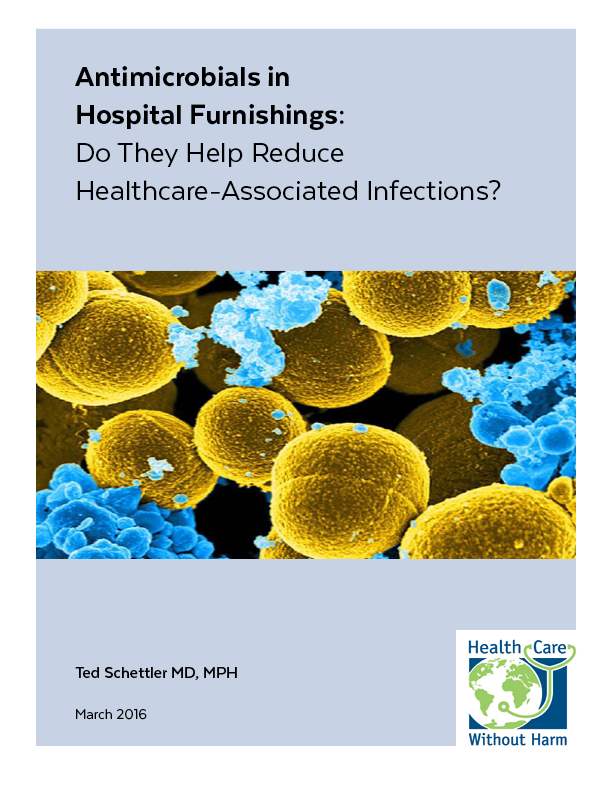Evidence Lacking To Support Use of Antimicrobials in Health Care Furnishings
Need for more data on safety suggests thinking twice
 [Washington, DC] Health care decision-makers should seek more evidence of safety and effectiveness before purchasing furnishings containing antimicrobials, concludes a comprehensive review released today by Health Care Without Harm. The report found very little support for the assumption that adding antimicrobials to furnishings was associated with reductions in healthcare-associated infections (HAIs). There are also limited data on the safety of the practice, yet purchase of these products is expected to increase.
[Washington, DC] Health care decision-makers should seek more evidence of safety and effectiveness before purchasing furnishings containing antimicrobials, concludes a comprehensive review released today by Health Care Without Harm. The report found very little support for the assumption that adding antimicrobials to furnishings was associated with reductions in healthcare-associated infections (HAIs). There are also limited data on the safety of the practice, yet purchase of these products is expected to increase.
The report recommends action by health care leaders, manufacturers, and the research community – including an urgent call to better understand the risks, tradeoffs, and cost implications of adding antimicrobials to furnishings before these products are widely distributed throughout the health care environment.
Among other recommendations, health care purchasers are advised to not buy furniture with antimicrobials unless they have undergone U.S. Environmental Protection Agency evaluation and registration under the Federal Insecticide, Fungicide, and Rodenticide Act (FIFRA) and have been shown to reduce healthcare-associated infections in a clinical setting.
The purchase of furnishings containing antimicrobials is growing dramatically, largely based on the hope that they will reduce healthcare-associated infections, but to date the evidence for that hope is very slim.
“There is a rush to add antimicrobials to everything because of the very serious problem of healthcare-associated infections,” said Rachel Gibson, director of Health Care Without Harm’s Safer Chemicals Program. “While this may make sense for some medical devices, the research just does not yet support their widespread use in furniture as part of a comprehensive infection control program.”
The growing use of products containing antimicrobials can increase the risk of antibiotic resistance, engender a false sense of security with reduced attention to cleaning and disinfection, and increase costs of products and materials. The report recommends that before we introduce these chemicals widely into our hospitals and our communities, it is critical to better understand the full implications of that action.
Healthcare-associated infections are a formidable challenge in hospitals and are major causes of morbidity and mortality today. They can prolong the length of hospital stays, result in readmission after discharge, and increase costs to individuals, families, and communities. Under provisions of the Affordable Care Act, preventable readmissions can result in a financial penalty in reimbursement for all Medicare patients at that hospital.
In response to this concern, manufacturers of health care furnishings have been developing new products with antimicrobial properties anticipating that this may help reduce the risk of HAIs. Although some antimicrobials clearly reduce the microbial load on textiles and other environmental surfaces in laboratory settings, they have rarely been evaluated in well-designed clinical studies for their effectiveness in contributing to HAI reduction.
At the same time, antimicrobial use in other consumer products, including items for food production and storage, personal care, clothing, household goods, and building materials, is also increasing. These uses collectively add to the potential for general population and environmental exposures. Unfortunately, data on the safety and efficacy of this growing practice are scarce, and potential unintended consequences have not been fully explored.
“Evaluation of the benefits at the point of use, life cycle risks, tradeoffs, and financial implications of adding antimicrobials to products in hospitals will help product designers, purchasers, infection preventionists, and environmental services personnel make informed decisions,” the report concludes. “Until then, design and purchasing decisions will be based mostly on unverified assumptions rather than objective data.”
For media inquiries, please contact: Benn Grover, Health Care Without Harm
888-461-0112 / brover@hcwh.org
About Health Care Without Harm
Health Care Without Harm seeks to transform the health sector worldwide, without compromising patient safety or care, so that it becomes ecologically sustainable and a leading advocate for environmental health and justice. To learn more about Health Care Without Harm, visit www.noharm.org.
About Practice Greenhealth
Practice Greenhealth is the nation’s leading health care community that empowers its members to increase their efficiencies and environmental stewardship while improving patient safety and care through tools, best practices and knowledge. To learn more about Practice Greenhealth, visit www.practicegreenhealth.org.
About Healthier Hospitals
Healthier Hospitals (HH) was launched in 2012 as a three-year national campaign designed to implement a new approach to improving environmental health and sustainability in the health care sector. HH was led by three nonprofits—Health Care Without Harm, Practice Greenhealth, and Center for Health Design—with the help of 12 sponsoring health systems. Moving forward, Healthier Hospitals continues to help hospitals and health care systems reduce their impact and improve health as a free program of Practice Greenhealth. More information is available at www.healthierhospitals.org.
###
